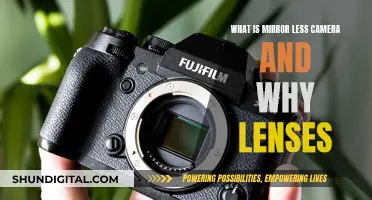
Knowing the width of your camera lens is important when buying filters, lens caps, or other equipment. The easiest way to identify a lens is by its focal length, with common focal lengths being 24mm, 50mm, and 85mm. However, this is different from the diameter of the lens. The diameter of your lens determines the size of the threaded filter you can use. Generally, larger diameters require more expensive and harder-to-find filters. You can usually find the diameter of your lens written on it, denoted by the symbol ø followed by a number indicating the diameter in millimetres. If it's not marked, you can measure the widest part of the lens with a ruler or calipers. Common DSLR lens diameters include 49mm, 52mm, 58mm, 62mm, 72mm, and 77mm.
| Characteristics | Values |
|---|---|
| How to find the lens diameter | The diameter is often marked on the lens using the symbol "ø" followed by a number (e.g. ø52 for 52mm). If not marked, measure the widest part of the lens or refer to lens specifications. |
| Lens diameter vs. focal length | The lens diameter is different from the focal length (e.g. 50mm) and aperture (e.g. f/1.8). The focal length is the distance from the sensor to the point of convergence, or where all light passes through the lens and reaches the sensor. |
| Common DSLR lens diameters | 43mm, 49mm, 52mm, 58mm, 62mm, 72mm, and 77mm. |
| Lens diameter and filter size | The lens diameter determines the size of the threaded filter. The larger the diameter, the more expensive the filter. |
| Lenses that don't allow traditional filters | Wide-angle lenses below 24mm require a special mount and filter due to the curvature of the outer glass. Some lenses, like very long telephoto lenses, have a large front element that makes a filter impractical. |
| Measuring the lens diameter | Measure the distance across the widest part of the lens, starting from the inside rim of the threaded area on one side to the inside rim on the other side. |
| Common diameters for DSLR lenses | 37mm, 39mm, 40mm, 40.5mm, 43mm, 46mm, 49mm, 52mm, 55mm, 58mm, 60mm, 62mm, 67mm, 72mm, 77mm, 82mm, 86mm, and 95mm. |
What You'll Learn

How to find the lens diameter
The lens diameter is important to know when buying filters, lens caps, or hoods. It is different from the focal length and aperture of a lens. The diameter of a lens is the physical measurement of the front-most part of the lens.
- The diameter is often marked on the lens using the symbol "ø" followed by a number (e.g. ø52 for 52mm). This is the universal symbol for diameter and it will always come before the number. It may be lightly etched or printed on the lens, so it can be hard to spot.
- If the diameter is not marked on the lens, you can refer to the lens specifications in the user manual or on the manufacturer's website.
- If you cannot find the diameter in the specifications, you can measure the widest part of the lens with a ruler or calipers. Measure the distance across the lens, passing through the middle of the circle, from the inside rim of the threaded area on one side to the other. Common DSLR lens diameters include sizes like 43mm, 49mm, 52mm, 58mm, 62mm, 68mm, 72mm, and 77mm.
Camera Lenses: Face Distortion and the Art of Photography
You may want to see also

Lens diameter vs focal length
When shopping for a camera lens, it's important to know the difference between lens diameter and focal length. These two specifications are often confused with each other, but they refer to different measurements.
Lens Diameter
Lens diameter is the physical measurement of the diameter of the front-most part of the lens. It is needed when buying filters, lens caps, or hoods. The diameter is often marked on the lens using the symbol "ø" followed by a number (e.g. ø52 for 52mm). Common DSLR lens diameters include 52mm, 58mm, 72mm, and 77mm. There is no standard lens diameter size, but some diameters are more common than others.
Focal Length
Focal length is the distance from the lens to the film when focused on a subject at infinity. In other words, it is the distance that the lens needs to be from the film in order to form a clear image of a far-away subject. Common focal lengths include 24mm, 50mm, and 85mm.
It's important to distinguish between lens diameter and focal length when shopping for camera equipment. For example, if you have a DSLR lens with a focal length of 50mm, you would not use a 50mm filter—these are two different measurements. The lens diameter determines the size of the threaded filter, while the focal length affects the field of view and magnification of the lens.
In summary, lens diameter and focal length are two important specifications to consider when choosing a camera lens. Lens diameter affects the amount of light that can enter the lens and the size of filters and other attachments, while focal length affects the focus, magnification, and field of view of the lens.
Polarized Camera Lenses: Worth the Investment?
You may want to see also

Why you need to know the lens diameter
When shopping for a new lens, filters, or other equipment, knowing the diameter of your camera lens is essential. The diameter of your lens determines the size of the threaded filter you can use. Generally, larger diameters require more expensive and harder-to-find filters.
The diameter of your lens is also important when purchasing lens caps. While lens caps are typically sold as standard sizes, knowing the diameter of your lens ensures you get the right size.
Additionally, the diameter of your lens can impact the ability to use certain filters. Some lenses, especially wide-angle lenses, may require a special mount and filter due to the curvature of the outer glass.
You can usually find the lens diameter marked on the lens itself, often using the symbol "ø" followed by a number (e.g., ø52 for 52mm). If the diameter is not marked, you can measure it with a ruler or refer to the lens specifications.
In summary, knowing the diameter of your camera lens is crucial for buying the correct size filters and lens caps, and for understanding the limitations of certain filters with specific lenses.
Black Friday Camera Lens Deals: What to Expect
You may want to see also

How to measure the lens diameter
When buying filters, lens caps, or hoods, you need to know the diameter of your lens. However, you don't need to measure it with a ruler or caliper. Instead, look for the code.
The lens diameter is often marked on the lens using the symbol "ø" followed by a number (e.g. ø52 for 52mm). It is usually printed or etched into the front of the camera lens or engraved on the side near the top, where you would screw on your lens filter. It is often marked without any colour, so it may be hard to spot.
If the diameter is not marked on the lens, you can measure the widest part of the lens or refer to the lens specifications. Measure the distance across the widest part of the lens (i.e. going through the middle of the circle), starting from the inside rim of the threaded area on one side to the inside rim of the thread on the other side. This will provide the maximum diameter of a filter that will screw into that thread.
Cameras and Lenses: Separate but Interdependent Pieces
You may want to see also

What to do if your lens doesn't have the diameter marked
If your lens doesn't have the diameter marked, you can try the following methods to determine its size:
Refer to the Lens Specifications:
Check the lens specifications provided by the manufacturer, either in the user manual or on their website. The lens diameter information should be included in the technical specifications.
Measure the Widest Part of the Lens:
Use a ruler or calipers with millimetres marked on it to measure the widest part of the lens. Measure from the inside rim of the threaded area on one side to the inside rim of the thread on the other side. This will give you the maximum diameter of a filter that can screw into that thread. Common DSLR lens diameters include sizes like 43mm, 49mm, 52mm, 58mm, 62mm, 68mm, 72mm, and 77mm.
Trial and Error:
If you don't have access to the lens specifications and are unsure about measuring, you can try a trial-and-error approach. Start by measuring your lens and then referring to common DSLR lens diameters. Try finding a filter that matches the closest standard size.
Lens Filter Size Charts:
Online lens filter size charts are available for various camera brands, including Canon, Nikon, Sony, Fujifilm, Olympus, Pentax, and Sigma. These charts list the lens models along with their corresponding filter sizes. You can find the chart for your specific camera brand and look up the filter size for your lens model.
Remember, the lens diameter is different from the focal length and aperture. The diameter refers specifically to the physical measurement of the front-most part of the lens, which is important for attaching filters, lens caps, or hoods.
Lens and Camera Compatibility: Are Lenses Camera-Specific?
You may want to see also
Frequently asked questions
The width of your camera lens is referred to as its diameter. This is different from the focal length of your lens. The easiest way to find the diameter is to look for a number followed by the symbol ø on the front or side of the lens. This number is the diameter in millimetres. If you can't find this information on the lens, you can measure the diameter with a ruler or tape.
If the diameter isn't marked on your lens, you can measure it with a ruler or tape. Measure the distance across the widest part of the lens, passing through the middle of the front element. This will give you the diameter of your lens in millimetres.
Knowing the diameter of your lens is important when buying filters, lens caps, or hoods, as these accessories need to fit correctly onto the front of your lens.







